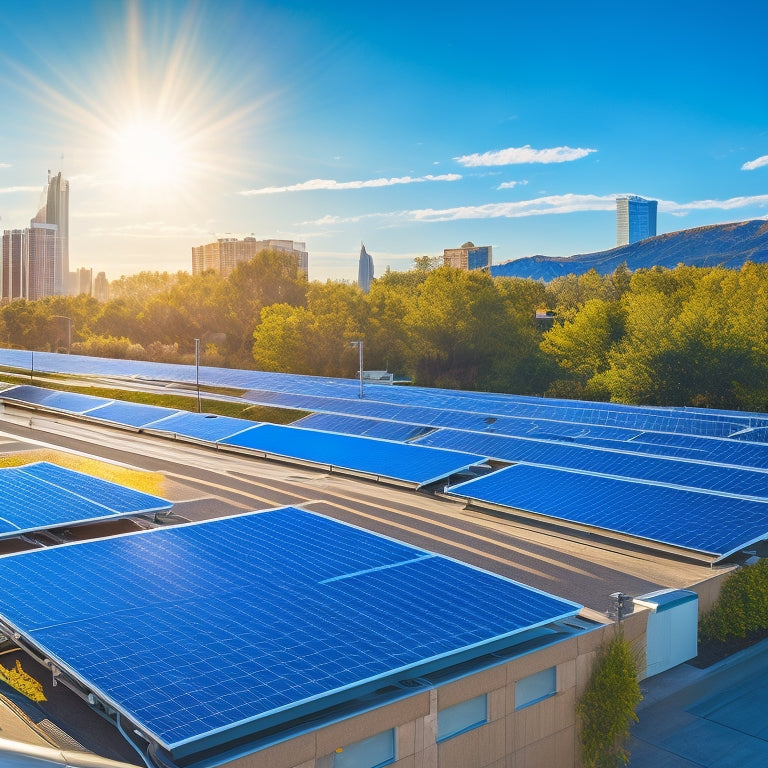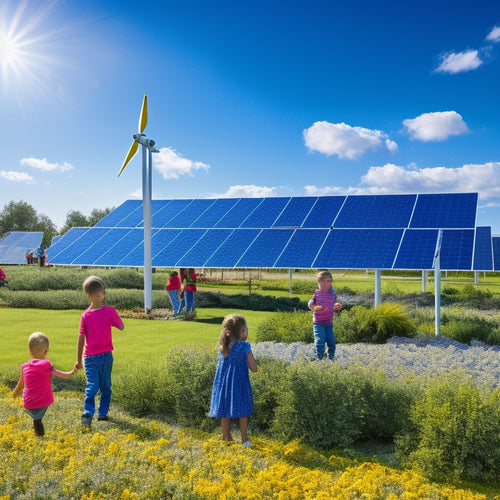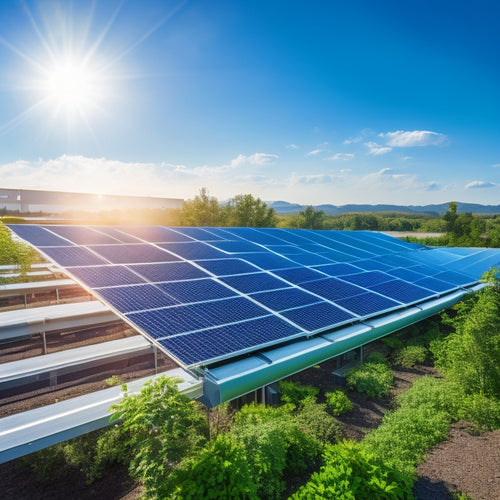
What Commercial Solar Panels Are Right for You?
Share
Choosing the right commercial solar panels hinges on your energy needs and budget. Monocrystalline panels offer high energy output and superior weather resistance but come with a higher upfront cost. Alternatively, polycrystalline panels are budget-friendly and highly durable, though less efficient. Brands like SunPower, LG, and Panasonic provide high-efficiency options with unique technologies. Consider the energy conversion rate, temperature coefficient, and lifespan when selecting panels. Additionally, examine tax incentives, ROI, and potential savings on electricity bills. Proper installation, regular maintenance, and performance monitoring are essential for ideal results. Discover more about aligning these factors with your specific requirements.
Key Takeaways
- Assess energy needs to choose between high-efficiency monocrystalline and budget-friendly polycrystalline panels.
- Consider top brands like SunPower, LG, and Panasonic for reliable performance and advanced technologies.
- Evaluate financial viability through ROI, payback period, and available tax incentives.
- Ensure optimal installation with maximum sun exposure and minimal shading for peak performance.
- Review customer feedback on energy yield, maintenance frequency, and overall satisfaction to identify the best panels.
Understanding Your Energy Needs
To effectively choose commercial solar panels, you need to first assess your energy consumption patterns and peak demand requirements. Begin by conducting a thorough energy assessment to understand how much electricity your business consumes daily, weekly, and monthly. This involves analyzing utility bills, identifying consumption spikes, and recognizing peak usage times.
Performing a detailed consumption analysis is essential. By examining your energy usage over time, you can uncover inefficiencies and pinpoint the exact times when your energy demand is highest. This data helps in determining the capacity of the solar panel system you'll need and guarantees it can handle peak loads without overloading or underperforming.
Use energy monitoring tools or consult with a professional energy auditor to gather accurate and detailed data. This step isn't just about knowing your total energy consumption; it's about understanding the nuances of your energy use. For example, heating, ventilation, and air conditioning (HVAC) systems often create significant energy draws during specific periods.
Incorporating this detailed energy assessment and consumption analysis into your planning will enable you to select a solar solution that's tailored to your business's unique needs, optimizing efficiency and cost savings.
Monocrystalline Vs. Polycrystalline
When deciding between monocrystalline and polycrystalline panels, you'll need to take into account efficiency, cost, and durability.
Monocrystalline panels typically offer higher efficiency and performance but come at a higher investment.
On the other hand, polycrystalline panels are more budget-friendly but may have a shorter lifespan and slightly lower efficiency.
Efficiency and Performance
Understanding the efficiency and performance differences between monocrystalline and polycrystalline solar panels is essential for making an informed decision about your commercial solar energy investment.
Monocrystalline panels are renowned for their high energy output and superior efficiency rates, often reaching 20% or more. This is due to the high purity of the silicon used, which allows for better electron flow. They also boast a lower temperature coefficient, meaning their performance degrades less in high temperatures, an important factor for maximizing energy production in warmer climates.
On the other hand, polycrystalline panels, while generally less efficient (averaging around 15-17%), still offer reliable performance. They're made from silicon fragments melted together, which results in a higher temperature coefficient. This means they lose efficiency more quickly as temperatures rise, potentially affecting your energy output during hot weather. However, they tend to perform adequately in milder climates and can be a practical choice depending on your specific environmental conditions.
Cost and Investment
When evaluating the efficiency and performance of monocrystalline and polycrystalline solar panels, it's equally important to take into account the cost and investment implications for your commercial solar energy project. Monocrystalline panels, known for their higher efficiency rates, generally come with a steeper upfront cost. However, this initial expense can be offset by their enhanced performance, potentially reducing the payback period and improving the overall return on investment (ROI).
Polycrystalline panels, while less efficient, are more budget-friendly. They offer a lower initial cost, making them a compelling choice if you're looking to minimize upfront expenditure. Despite their lower efficiency, polycrystalline panels can still provide substantial energy savings, especially when paired with financial incentives such as tax credits, rebates, and grants.
Your choice between monocrystalline and polycrystalline should take into account the specific financial incentives available in your region. These incentives can have a significant impact on the total cost of ownership and ROI. For instance, with robust incentives, the higher initial investment in monocrystalline panels might be more justifiable. Conversely, if incentives are limited, polycrystalline panels may offer a more attractive path to financial viability. Balancing cost with efficiency and available incentives will help you make a well-informed decision for your commercial solar energy project.
Durability and Lifespan
Both monocrystalline and polycrystalline solar panels offer impressive durability, with lifespans typically ranging between 25 to 30 years. When considering material quality, monocrystalline panels generally have a slight edge. They're made from single-crystal silicon, which provides a higher degree of structural integrity. This contributes to their superior weather resistance, particularly in extreme conditions such as high winds, heavy snow, and intense heat.
Polycrystalline panels, composed of multiple silicon fragments melted together, are also highly durable. However, their slightly lower purity can make them marginally less efficient in adverse weather conditions. Still, advancements in manufacturing have significantly narrowed this gap, making polycrystalline a viable option for many commercial applications.
In terms of practical advice, if your commercial facility is located in an area prone to severe weather, opting for monocrystalline panels might be a wise investment. Their enhanced material quality can translate to fewer maintenance issues over time.
Conversely, if you're in a milder climate, polycrystalline panels will still offer robust performance and durability at potentially lower upfront costs. Ultimately, both types provide long-lasting solutions, but evaluating your specific environmental conditions and budget can guide you to the right choice.
Top Solar Panel Brands
Choosing the appropriate solar panel brand is essential for optimizing your investment, and top players like SunPower, LG, and Panasonic consistently deliver exceptional performance and durability.
When evaluating these brands, consider their reputation and the variety of products they offer. SunPower is renowned for its high-efficiency panels and robust warranties, making it a top choice for commercial applications. Their Maxeon series, for instance, is engineered for long-term reliability and superior energy output.
LG, another industry leader, offers a wide range of panels catering to different needs and budgets. Their NeON series is particularly notable for its advanced cell technology and sleek design, which can enhance the aesthetic appeal of your commercial installation. LG's strong brand reputation is backed by solid performance metrics and thorough warranties.
Panasonic, known for both consumer electronics and solar technology, brings a wealth of expertise to its solar products. Their HIT (Heterojunction with Intrinsic Thin layer) panels stand out for their high efficiency and temperature performance, important for maintaining output in varying conditions. With a broad product variety and excellent customer support, Panasonic remains a reliable choice for commercial solar solutions.
Efficiency and Performance
Maximizing the efficiency and performance of commercial solar panels hinges on understanding key metrics like energy conversion rates and temperature coefficients. Energy conversion rate, expressed as a percentage, reflects how much sunlight the panel converts into usable electricity. Higher rates mean more power output for your energy consumption needs. Temperature coefficient, on the other hand, indicates how performance drops as temperatures rise. Lower coefficients mean less efficiency loss in hot conditions.
To help you evaluate, consider the table below:
| Metric | Importance |
|---|---|
| Energy Conversion Rate | Determines overall panel efficiency |
| Temperature Coefficient | Affects performance in high heat |
| Power Output | Directly impacts energy yield |
When selecting commercial solar panels, aim for those with high energy conversion rates and low temperature coefficients. This guarantees optimal power output and reduces the impact of fluctuating temperatures on your energy consumption.
Additionally, keep an eye on the power output rating, typically measured in watts. A higher power output means fewer panels are needed to meet your energy consumption goals. This can save on installation space and costs. By focusing on these metrics, you'll make an informed decision that maximizes efficiency and performance for your commercial solar panel setup.
Durability and Warranty
When evaluating commercial solar panels, considering their durability and the warranty provided is crucial, as these factors directly impact long-term investment returns. Material quality plays a significant role in a panel's longevity and resistance to environmental wear and tear. High-grade materials, such as tempered glass and corrosion-resistant aluminum frames, often guarantee better performance in harsh conditions.
To make an informed decision, consider the following:
-
Panel Construction: Look for panels with robust materials that withstand extreme weather conditions, including high winds, heavy snowfall, and intense sunlight.
-
Degradation Rate: Panels with a lower degradation rate maintain efficiency longer, leading to more energy production over time.
-
Warranty Length: A longer warranty often indicates manufacturer confidence in the product. Typical warranties range from 10 to 25 years for performance and product quality.
- Environmental Impact: Choose panels designed for minimal environmental impact, ensuring they're recyclable and produced through sustainable practices.
Cost and Budgeting
Understanding the financial aspects of commercial solar panels is essential for making an informed investment decision. First, evaluate your budget and consider various financing options. You can purchase solar panels outright, but leasing or power purchase agreements (PPAs) can reduce your initial capital expenditure. Each option has its advantages and drawbacks, so analyze them carefully.
Here's a quick comparison:
| Financing Option | Pros | Cons |
|---|---|---|
| Purchase | Long-term savings, full ownership | High upfront cost |
| Lease | Lower initial cost, maintenance included | Monthly payments, no ownership |
| PPA | Pay only for energy used, no upfront cost | Long-term contract, variable rates |
Next, consider tax incentives, which can greatly reduce your costs. Federal Investment Tax Credit (ITC) allows you to deduct 26% of the installation cost from your federal taxes. Additionally, many states offer their own incentives, including rebates and grants. These incentives can make solar panels more affordable and enhance your return on investment.
Don't overlook operational savings. Solar panels can reduce your electricity bills, providing long-term financial benefits. By analyzing your energy needs and potential savings, you can develop a clear picture of the financial viability of your solar investment.
Installation and Maintenance
Proper installation and regular maintenance of your commercial solar panels guarantee peak performance and longevity. First, consider the installation location. Ideal sites are those with maximum sun exposure and minimal shading. Rooftops and open fields are common choices, but always evaluate structural integrity and local regulations.
When installing, make sure that the angle and tilt of your panels maximize solar energy capture. An expert installer will use precise calculations to align your panels. It's important to follow these steps meticulously to avoid energy loss and mechanical issues.
In terms of maintenance, establishing an effective maintenance schedule is essential. Regular check-ups can identify and rectify minor issues before they escalate.
Here's a basic maintenance checklist:
- Visual Inspections: Inspect for debris, cracks, or shading that could impact efficiency.
- Cleaning: Remove dirt and grime regularly to maintain optimal light absorption.
- Electrical Checks: Verify connections, inverters, and wiring for any signs of wear or malfunction.
- Performance Monitoring: Use software tools to track energy output and identify drops in performance.
Adhering to these guidelines ensures your solar panels operate efficiently, delivering consistent returns on your investment. Professional maintenance services can provide detailed assessments and advanced troubleshooting when needed.
Online Shopping Tips
When shopping online for commercial solar panels, make sure you compare prices across multiple vendors to get the best deal.
Pay close attention to warranty terms to avoid unexpected costs down the line.
Additionally, verify that the seller offers professional installation services to guarantee peak performance.
Compare Prices Wisely
To get the best deal on commercial solar panels, you'll need to harness the power of price comparison tools and user reviews online. By analyzing bulk discounts and price trends, you can make an informed decision that maximizes your investment.
Start by using price comparison websites to identify competitive rates. These platforms allow you to filter results based on your specific needs. Additionally, keep track of price trends to determine the ideal time to make your purchase. Prices for solar panels can fluctuate based on factors like technological advancements and market demand.
Here are four practical steps to follow:
-
Research Bulk Discounts: Suppliers often offer significant savings when you buy in large quantities. This can be a cost-effective strategy if you're outfitting a large facility.
-
Monitor Price Trends: Regularly check price trends to identify when prices are likely to drop. Timing your purchase right can save you a considerable amount.
-
Read User Reviews: User feedback can provide insights into the performance and reliability of different brands and models.
- Use Price Aggregators: Websites that aggregate prices from multiple suppliers can help you quickly compare options and pinpoint the best deals.
Check Warranty Details
Always examine the warranty details to make sure you're covered for potential defects and performance issues before finalizing your purchase. The standard warranty for commercial solar panels typically includes a product warranty and a performance warranty.
The product warranty covers defects in materials and workmanship, while the performance warranty guarantees that the panels will maintain a certain level of efficiency over time.
When scrutinizing warranties, pay close attention to the coverage period. A longer coverage period can offer you peace of mind, providing ongoing protection. Most product warranties range from 10 to 25 years, while performance warranties often extend up to 25 years or more.
Don't overlook the terms of an extended warranty, which can provide additional coverage beyond the standard period.
It's essential to understand what's included and what's excluded in the warranty. Some warranties may not cover issues caused by improper installation or environmental factors. Ensure the manufacturer's warranty is backed by a reputable company with a solid track record.
Verify Installation Services
Guaranteeing the installation services meet industry standards is crucial for the long-term performance and efficiency of your commercial solar panels. You can't underestimate the importance of selecting certified technicians who adhere to best practices.
Here are some key steps to verify the quality of installation services:
-
Check Certifications: Make sure the technicians have relevant certifications such as NABCEP (North American Board of Certified Energy Practitioners). Certified technicians guarantee adherence to industry standards, ensuring excellent performance and safety.
-
Investigate Local Providers: Local providers often offer better support and faster service. Investigate their reputation through online reviews and local business bureaus. A well-regarded local installer can provide ongoing maintenance and quicker troubleshooting.
-
Request Case Studies: Ask for case studies or references from previous commercial installations. This will give you insight into their expertise and reliability. A credible installer should have a portfolio showcasing successful projects.
- Review Warranties and Guarantees: Installation services should come with warranties that cover workmanship and potential defects. Verify these details to make sure you're protected against future issues.
Customer Reviews and Ratings
Essential, to take into account
Frequently, customer reviews and ratings provide invaluable insights into the performance and reliability of commercial solar panels. User testimonials serve as real-world evidence of a product's efficacy, helping you gauge whether a particular model meets its advertised specifications. Through detailed feedback analysis, you can identify common issues, such as degradation rates, efficiency under various weather conditions, and long-term durability.
When evaluating reviews, focus on metrics like energy yield, maintenance frequency, and overall satisfaction. Look for patterns in the feedback; if several users mention that a panel consistently underperforms in low-light conditions, it's a red flag. Conversely, numerous positive reviews about high efficiency and low maintenance can indicate a reliable product.
It's also essential to take into account the context of each review. Commercial installations vary widely in scale and application, and what works for a small business may not be suitable for a large industrial facility. Pay attention to the specifics mentioned by reviewers, such as the type of inverter used, the installation environment, and the local climate.
Frequently Asked Questions
How Do Solar Panels Affect Property Value?
Solar panels can increase your property's value substantially. Real estate market trends show buyers favor energy-efficient homes, potentially boosting resale prices. They're a smart investment, aligning with sustainable living and reducing long-term energy costs.
Can Solar Panels Be Installed on Any Type of Roof?
Absolutely, you can install solar panels on nearly any type of roof! However, consider roof materials and structural considerations. For instance, asphalt shingles are ideal, but more complex roofs like slate or tile might need additional support.
Are There Any Government Incentives for Installing Commercial Solar Panels?
You'll find several government incentives for installing commercial solar panels, including tax credits and rebate programs. These incentives can greatly reduce your upfront costs, making solar energy a more cost-effective and sustainable investment for your business.
What Is the Typical Lifespan of a Commercial Solar Panel System?
When considering the typical lifespan of a commercial solar panel system, you're looking at a solid 25-30 years. With minimal maintenance requirements, these systems maintain impressive energy output, ensuring long-term efficiency and sustainability.
How Do Commercial Solar Panels Perform in Extreme Weather Conditions?
Commercial solar panels perform well in extreme weather conditions due to advanced weatherproofing measures. They can withstand temperature fluctuations, ensuring consistent energy output. Proper installation and maintenance are essential for peak performance in various environmental scenarios.
Conclusion
Choosing the right commercial solar panels is like finding the perfect pair of running shoes. You wouldn't pick just any pair; you'd consider fit, durability, and performance.
With 25% higher efficiency from top brands, it's clear some panels outshine others. Remember Joe's bakery—after switching to monocrystalline panels, he reduced energy costs by 30%.
Prioritize your energy needs, weigh the pros and cons, and you'll be well on your way to a brighter, more efficient future.
Related Posts
-

Solar Power for Community Energy Independence
Solar power is essential for your community's energy independence, offering both environmental and economic benefits....
-

Evaluating Solar Power Options for Businesses
Evaluating solar power options for your business can greatly reduce energy costs and enhance sustainability. Start by...
-

Solar Energy Efficiency Improvements for Businesses
Improving solar energy efficiency for your business can lead to considerable cost savings and enhance your sustainabi...


